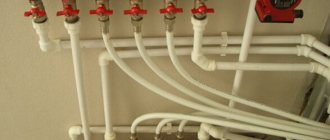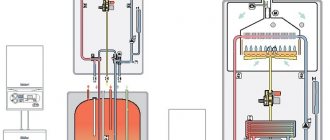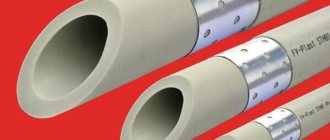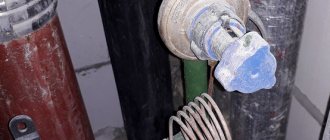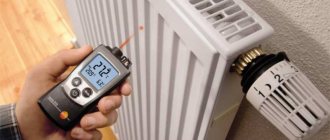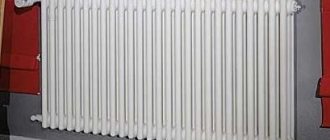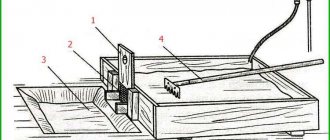Features of using propylene glycol
Propylene glycol has a freezing point of −60 °C and boils at 187.4 degrees. The temperature range of the liquid phase is 247 °C (water is only 100 degrees). Such a temperature range is not always needed, so solutions are used.
Propylene glycol is completely soluble in water. Aqueous solutions have a working temperature range depending on the concentration (see table below). The higher the percentage of propylene glycol, the lower the freezing point and the more expensive the coolant.
Based on the substance, multicomponent coolants are made. They may also include:
- Water softeners;
- Inhibitors;
- Anti-foaming agents;
- Additives for surface restoration;
- Anti-corrosion additives;
- Absorbents.
Propylene glycol does not produce a lot of vapor. Therefore, in the event of a leak, there is no need to completely replace the coolant in the system. It can be refilled.
The shelf life of propylene glycol and its solutions is 5 years or more if stored in sealed containers at temperatures above +55 degrees. The shelf life of coolants based on it depends on the composition of the components. It is indicated on the packaging or in the specification.
Polypylene glycol in 200 liter barrels.
Application of water
The method of transferring heat from a source to radiators using water is the simplest and at the same time the least expensive . Water accounts for at least 70% of the total number of liquids used.
Despite the apparent simplicity of application, there are a number of points that must be taken into account:
- Rigidity. There are solid particles in water. When heated above 70 degrees, the crystallization process begins, which, in turn, leads to the appearance of scale on the internal surfaces of the boiler heat exchanger, pipelines, and batteries. To combat this phenomenon, there are water softening devices that also purify water from mechanical pollution. Such devices are connected directly to the water supply. When connected in this way, there is no need to install an additional pump to fill the system. Filling occurs due to pressure in the water supply network.
- Temperature regime. When providing heat to a separate building, the supply temperature rarely exceeds 95 degrees. Most domestic heating boilers are also designed for this temperature as the maximum. At this temperature, the liquid does not boil. It must be remembered that at a temperature of 80 degrees, the process of deaeration begins (the release of air particles from the water). To prevent airing of the system, it is necessary to install air valves that will automatically release the air that appears.
- Freezing temperature. If the room is heated regularly, then this problem will not arise. If the heating of the room is not carried out on an ongoing basis, but from time to time, then it is necessary to take into account that at 0 degrees the water will freeze. Freezing of water in heating devices can lead to their failure for a long time or even to complete unusability.
Positive aspects of using water:
- Environmentally friendly substance.
- Has a high heat capacity.
- Does not require additional energy costs to ensure circulation.
- If it is necessary to fill the system , it is always available.
- Low cost.
Negative sides:
- Turns into ice at 0 °C.
- The need to install a water treatment device.
Application
Propylene glycol and its solutions are used as a coolant in climate control equipment. They have a low freezing point, which is why they are also called antifreeze. Propylene glycol solutions and coolants based on it are used in:
- Chiller-fan coil systems;
- Solar vacuum and flat collectors;
- Heat pumps;
- Heating and hot water systems;
Pure propylene glycol is used in other areas:
- In the production of cosmetics;
- In the food industry;
- As a liquid solvent for electronic cigarettes;
- To moisten tobacco;
- When disinfecting premises;
- In the production of unsaturated polyester resins;
- As a plasticizer in the manufacture of polymer films.
Propylene glycol in bottles for food use.
Industrial Use
Our research shows that even with complete crystallization of our solutions, at maximum negative temperatures, the state of the product will not lead to rupture of pipelines in the climatic conditions of Central Russia. Also, due to the high boiling point of Propylene glycol, there is no large loss of liquid due to evaporation. Propylene glycol has relatively low toxicity and provides the main frost resistance of the product.
The critical heat transfer coefficients of our solutions do not differ much from the similar coefficient of ordinary tap water without impurities when transferring heat to the atmosphere through radiators, therefore they can be used in heating systems without restrictions.
The amount of heat that can be transferred to the atmosphere through RVP solutions is practically no different from that of water; thus, there is no need to change the area of the heat exchange surfaces.
Because our Propylene Glycol solutions have higher viscosity and density than regular water, you should expect greater pressure drops in pipelines and other equipment when using them.
Physico-chemical properties of propylene glycol
| Indicator | Meaning |
| Chemical formula | C3H8O2 |
| Molar mass | 76.09 g/mol |
| Density | 1.0363 g/cc |
| Dynamic viscosity | 0.056 Pa s |
| Kinematic viscosity (at 20 °C) | 0.054 cc/s |
| Melting temperature | −60 °C |
| Boiling temperature | 187.4 °C |
| Flash point | 101.7 °C |
| Flash point | 104.4 °C |
| Auto-ignition temperature | 421 °C |
| Specific heat | 2483 J/(kg K) |
| Thermal conductivity | 0.218 W/(m K) |
| Steam pressure | 10.7 Pa |
| Specific heat of evaporation | 914 kJ/kg |
Flash point is the lowest temperature of a volatile condensed substance at which vapors above the surface of the substance are capable of flashing in air under the influence of an ignition source, but stable combustion does not occur after removal of the ignition source.
Wikipedia
Ignition temperature is the lowest temperature of a substance at which vapors above the surface of a flammable substance are released at such a rate that when exposed to an ignition source, ignition is observed.
Wikipedia
Freezing point of aqueous solutions of propylene glycol
| Concentration | Temperature | Density |
| Propylene glycol | °C | at 20°C |
| 0.2 | -6 | 1.014 |
| 0.25 | -10 | 1.019 |
| 0.31 | -15 | 1.023 |
| 0.36 | -20 | 1.028 |
| 0.42 | -25 | 1.032 |
| 0.45 | -30 | 1.035 |
| 0.5 | -35 | 1.038 |
| 0.55 | -45 | 1.04 |
| 0.6 | -55 | 1.042 |
| 0.65 | -57 | 1.043 |
| 0.7 | -58 | 1.044 |
| 0.7+ | -60 | 1,045+ |
Harm and toxicity to the body
According to the international classification, propylene glycol is an additive E1520. This means that it has been tested for a long time and its harm to the body has not been identified. But this only applies when consumed internally.
Propylene glycol is used in the manufacture of conventional and electronic cigarettes. And their smoking and vaping leads to lung cancer and the development of cardiovascular diseases. Scientists have not figured out which component causes these diseases.
It is possible that nicotine or other tar substances are to blame. But it may be that inhaling propylene glycol vapor is a negative factor . Therefore, when working with it and its solutions, it is recommended to observe safety precautions.
Safety precautions
When working with propylene glycol, the following rules must be observed:
- Store the substance in a hermetically sealed container;
- Use protection for the skin of your hands and face;
- Protect eyes and respiratory tract;
- Do not work near electrical appliances;
- Do not allow the mixture and vapors to heat above 100 °C;
- Do not use propylene glycol near heat sources;
- Do not allow propylene glycol or its vapors to come into contact with open flames.
In this article we examined the characteristics and properties of the coolant (antifreeze) of propylene glycol and mixtures based on it. We hope the publication was useful to you. You can leave your questions and opinions in the comments. Don't forget to share the article !
Loading…
Propylene glycol solution - antifreeze liquid for heating and cooling systems
To reduce the corrosive and stabilize the thermophysical properties of aqueous solutions of propylene glycol, eliminate foaming, prevent the formation of scale and remove existing scale, and increase thermal stability, special packages of inhibitors are used, containing about a dozen different substances (The quality characteristics of propylene glycol solutions must comply with the requirements of GOST 28084-89 “Anti-freezing coolants"
and specifications developed on its basis). Most ready-to-use concentrated coolants (antifreeze, antifreeze fluids) are a solution consisting of approximately 60%-65% propylene glycol, 30%-35% water and 3%-4% active additives. This combination allows you to obtain the best heat transfer performance. In this case, the mixture does not separate into components and has a crystallization onset temperature of approximately –60 °C.
Aqueous solutions of propylene glycol with a lower freezing point are obtained at a lower concentration of propylene glycol, but the mass fraction of additives (inhibitors) remains approximately unchanged. The dependence of the freezing temperature on the concentration of propylene glycol is given below in table. No. 1.
We offer environmentally friendly, high-quality aqueous propylene glycol solution
with the required crystallization temperature and guaranteed thermophysical characteristics over the entire range of operating temperatures for various climatic operating conditions:
An aqueous solution of propylene glycol is an ECO coolant, non-freezing liquid, antifreeze for heating, refrigeration and air conditioning systems (a package of anti-corrosion, anti-foam, anti-scale and stabilizing additives)
| Packaging, weight in kg | Concentration, % | Temperature of the onset of crystallization (freezing), t°C | Sale / Price in rub./kg with VAT, when ordering from 1 ton | Sale / Price in rub./kg with VAT, when ordering more than 2 tons |
| Canister 20 kg, can 50 kg | 47% | minus -30°C | 95.00 RUR/kg | depending on batch size |
| Barrel 220 kg | 31% | minus -15°C | 74.00 RUR/kg | depending on batch size |
| Barrel 220 kg | 37% | minus -20°C | 80.00 rub./kg | depending on batch size |
| Barrel 220 kg | 42% | minus -25°C | 87.00 RUR/kg | depending on batch size |
| Barrel 220 kg | 47% | minus -30°C | 92.00 RUR/kg | depending on batch size |
| Barrel 225 kg | 52% | minus -35°C | 103.00 rub./kg | depending on batch size |
| Barrel 225 kg | 56% | minus -40°C | 110.00 rub./kg | depending on batch size |
In recent years, there has been an intensive increase in the use of environmentally friendly coolant based on propylene glycol, including due to the transfer of many facilities from the use of ethylene glycol solutions to an aqueous solution of propylene glycol.
Since 1996, the USA, Germany, France, and subsequently, since 2001, throughout the European Union have abandoned the use of chemicals based on ethylene glycol in everyday life.
Properties and features of the use of an aqueous solution of propylene glycol
Recently, an aqueous solution of propylene glycol with additives for various purposes has been widely used as a coolant in autonomous heating and industrial air conditioning systems with high environmental requirements. The density of propylene glycol is 1.037 g/cm3 at 20 °C, the freezing point is –60 °C. Aqueous solutions with an increase in the concentration of propylene glycol to 70%, the crystallization (freezing) temperature decreases and reaches a value of –60 ° C at a concentration of ethylene glycol of 70%. With a further increase in concentration, the crystallization temperature remains almost unchanged - -60 ° C. When freezing, the propylene glycol solution goes into an amorphous state, forming a viscous mass with an increase in volume within slightly larger limits than the increase in the volume of water when it freezes.
Ready-made concentrated coolants based on propylene glycol are diluted with water before filling the system to obtain an aqueous solution with the required freezing point. For dilution, it is advisable to use distilled water; if it is unavailable, tap water with a hardness of up to 6 units. But it must be borne in mind that the use of untreated water is undesirable due to possible incompatibility with the additive package.
Dilution of concentrated propylene glycol by more than 50% leads to a noticeable deterioration in the consumer properties of the coolant.
It is possible to produce a high-quality aqueous solution of propylene glycol with the required crystallization temperature and stable thermophysical characteristics only under production conditions. Due to the fact that the operating instructions for the equipment of most heating and industrial air conditioning systems place high demands on the thermophysical properties of aqueous solutions, it is recommended to use ready-made aqueous solutions designed for the appropriate crystallization (freezing) temperature. Therefore, the CHIMTERMO company produces a whole series of high-quality aqueous solutions of propylene glycol
.
The consumer must take into account that due to a number of significant differences in the thermophysical properties of water and propylene glycol-based coolants, when using the latter, a number of technical features arise that require special attention.
The viscosity of propylene glycol solutions is 2–3 times greater than that of water, and accordingly, the hydrodynamic resistance to the movement of liquid (aqueous solution) in pipes will be higher, which will require a more powerful circulation pump (approximately 10% in performance and 60% in pressure).
An aqueous solution of propylene glycol also has a greater coefficient of thermal expansion than water, so it is necessary to use a large-volume expansion tank. The heat capacity of a propylene glycol solution is approximately 15% less than that of water, which worsens heat transfer conditions and requires the installation of more powerful radiators.
An aqueous solution of propylene glycol must not be overheated, as this will lead to an irreversible change in the chemical composition and properties of the aqueous solution.
of propylene glycol are mainly used.
with different concentrations.
The coolant
(antifreeze, antifreeze liquid) based on an aqueous solution of propylene glycol is environmentally friendly, explosion- and fireproof, has a certificate of conformity, a sanitary-epidemiological conclusion and is approved for use in the food and pharmaceutical industries, in residential and public buildings.
Table No. 1. Aqueous solution of propylene glycol
. Dependence of freezing temperature on its concentration.
| Propylene glycol concentration, % | Freezing temperature, °C | Propylene glycol concentration, % | Freezing temperature, °C |
| 5% | -2°C | 55% | -40°С |
| 11% | -4°С | 60% | -50°С |
| 15% | -6°С | 65% | -55°С |
| 20% | -8°С | 70% | -57°С |
| 25% | -10°С | 75% | -58°С |
| 30% | -13°С | 80% | -59°С |
| 38% | -20°С | 85% | -59°С |
| 42% | -25°С | 90% | -60°С |
| 47% | -30°С | 95% | -60°С |
| 50% | -35°С | 98% | -60°С |
We are interested in mutually beneficial cooperation.


